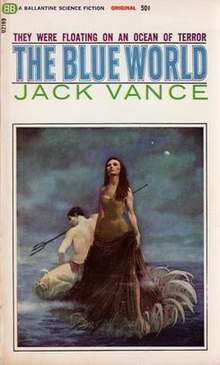The Blue World
 First edition | |
| Author | Jack Vance |
|---|---|
| Country | United States |
| Language | English |
| Genre | Science fiction |
| Publisher | Ballantine |
Publication date | 1966 |
| Media type | Print (paperback) |
| Pages | 190 pp |
| OCLC | 2304721 |
The Blue World is a science fiction adventure novel by American writer Jack Vance. The novel is based on Vance’s earlier novella "The Kragen", which appeared in the July 1964 edition of Fantastic Stories of Imagination.[1]
Plot summary
Sklar Hast, the protagonist, had achieved a measure of success and prosperity by passing his examination to be a “Hoodwink”, or semaphore tower operator – a prestigious position on the Blue World, a planet with no land at all. During the space of twelve generations, the descendants of a crashed prison ship have created a rudimentary civilization on the water-covered planet, living on huge sea plants. However, they must beware the kragen, giant, semi-intelligent squid-like predators which roam the ocean. The colonists eventually develop a relationship with one of these, King Kragen. It drives off other kragen in return for offerings of food organized by an entrenched quasi-religious priesthood built up over generations. King Kragen grows to become the largest and most powerful kragen, demanding more and more food as time goes by.
When Sklar questions the need to continue to worship and feed this predator, King Kragen appears, wrecks his home and kills his mentor. Rather than regard this as divine punishment, Sklar suspects that the conservative priesthood has enough control over King Kragen to kill those who oppose their views, and to thus uphold their privileged status.
Sklar's mission is to convince his fellow citizens that they must kill King Kragen in order to be free. And, if so, to discover how can they do it in a world without materials to make weapons.
Award nominations
The Blue World was nominated for the Nebula Award in 1966. It was also a preliminary nominee for the Prometheus Award for “Best Classic Libertarian SF Novel” in 1988, 1994, 1995 and 1996.[1]
References
- 1 2 The Blue World title listing at the Internet Speculative Fiction Database
Sources
- Underwood, Tim; Chuck Miller (1980). Jack Vance. New York: Taplinger Publishing Company. p. 228. ISBN 0-8008-4295-2.